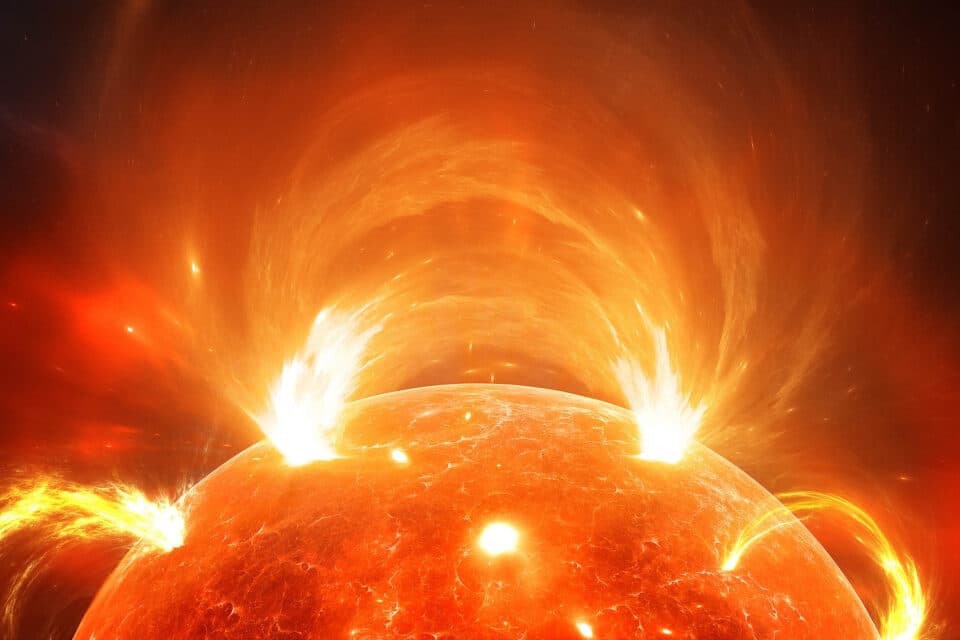UPDATE -- Severe solar storm warning issued by the NOAA • Earth.com
www.earth.com
A significant geomagnetic solar storm is currently in progress, sparked by recent solar eruptions that have hurled plasma towards Earth.
This atmospheric phenomenon is set to illuminate skies with the Northern Lights, extending unusually far south to regions including Alabama and Northern California as early as Monday.
March 24, 2024 at 6:00 pm Eastern Time
In an urgent communication dated March 24, 2024, the Space Weather Prediction Center (SWPC) announced a significant geomagnetic disturbance, marking a severe escalation in space weather conditions.
The issued alert highlighted a Geomagnetic K-index of 8, teetering on 9, a threshold that was crossed at 1628 UTC, within the synoptic period of 1500-1800 UTC.
This event has activated a severe (G4) warning on the NOAA Space Weather Scale, indicative of intense geomagnetic activity with potential wide-reaching impacts on both technology and natural phenomena.
Space Weather Scale explanation
The NOAA Space Weather Scale, a framework designed to categorize the severity of space weather events, details five levels of geomagnetic storms, G1 (Minor) to G5 (Extreme), each with distinct potential impacts on Earth’s infrastructure and environment.
The scale, which is thoroughly explained on the SWPC’s website, serves as a critical tool for understanding and preparing for the effects of space weather phenomena.
Current storm is a G4
The severity of the current event, classified as G4, suggests significant disturbances. Geomagnetically induced currents could pose widespread challenges to voltage control systems, potentially triggering protective measures that inadvertently disconnect crucial components of the power grid. Additionally, these currents may amplify in pipelines, further complicating the situation.
Spacecraft and satellite warnings
Spacecraft operations are also under threat, with increased risks of surface charging, which can damage satellite components.
Low Earth orbit satellites may face enhanced drag, affecting their trajectories and complicating tracking and orientation tasks.
These conditions not only disrupt satellite functionality but also impair services reliant on these satellites, including navigation and communication.
Auroras will be seen further south
One of the more visible consequences of such geomagnetic storms is the enhancement of the aurora borealis, or northern lights, which could potentially be observed as far south as Alabama and northern California, a rare spectacle for residents in these areas.
This phenomenon, while stunning, underscores the reach and power of the geomagnetic activity currently at play.
Navigation system impact
Moreover, the event is expected to severely impact navigation systems, with satellite-based navigation (GPS) services facing degradation or complete outages lasting hours.
This poses significant risks for sectors reliant on precise location services, including aviation, maritime navigation, and emergency response operations.
Communications systems at risk
Communication systems are not spared, as high-frequency (HF) radio signals, essential for long-distance communication without the reliance on satellite or wired networks, may experience sporadic performance or complete blackouts.
This disruption affects not only amateur radio enthusiasts but also professional networks that depend on HF radio, including aviation, maritime, and some military operations.
Visit the
Space Weather Prediction Center for more information.
*******
Geomagnetic storm warning issued (11:00 AM Eastern Time)
The National Oceanic and Atmospheric Administration’s (
NOAA) Space Weather Prediction Center (SWPC) heightened awareness with a Geomagnetic Storm Alert on Sunday.
This followed the detection of an X 1.1 solar flare and a subsequent coronal hole high-speed stream (CH HSS) by Sun-monitoring satellites.
Auroras may be seen as far south as Alabama
Auroras, both Northern and Southern Lights, are the mesmerizing result of solar particles colliding with Earth’s atmosphere. Initially, space experts anticipated the storm’s intensity to fluctuate between a G1 and G2 level, potentially escalating to G3 by Monday.
Contrary to these predictions, a severe G4 level storm has materialized within the last 24 hours, showcasing the dynamic and unpredictable nature of space weather.
The SWPC employs a five-point scale to classify geomagnetic storms, where a G1 rating indicates the mildest form of storm, typically yielding aurora displays over Alaska and Canada.
A storm reaching a G3 level could make the aurora visible in states like Washington, Wisconsin, and New York, provided the skies are clear. However, with the current G4 severity, the phenomenon could be observed as far south as Alabama and Northern California, a rare occurrence for these latitudes.
Geomagnetic intensity scale
The geomagnetic activity’s intensity is also gauged by ground-based magnetometers and measured on the Kp index scale, which spans from 0 to 9.
A previous G3 event recorded a high Kp-index, allowing the Northern Lights to dazzle observers as far south as Las Vegas last December.
Predictions for the current storm suggest a Kp-index of at least 6, potentially bringing the aurora within view for cities including Seattle, Minneapolis, Green Bay, and Syracuse, New York.
Solar Cycle 25 and its continued impact
Echoing these forecasts, the University of Alaska Fairbanks
Geophysical Institute anticipates heightened aurora activity reaching a Kp-6 level through Monday night. Despite the awe-inspiring displays, the SWPC reassures the public of no adverse impacts from the storm.
“There’s no need for concern, but we encourage everyone to stay informed about the storm’s progression by visiting our website,” the SWPC advised on Sunday.
The task of predicting the precise intensity of geomagnetic activity remains a complex challenge for space experts, compounded by the increasing frequency of such events.
This uptick in geomagnetic storms is attributed to the Sun entering the peak phase of its 11-year solar cycle, a period marked by the magnetic field’s reversal.
Solar Cycle 25, which commenced in 2019, is expected to continue until approximately 2030, indicating a period of heightened solar and geomagnetic activity ahead.
Visit the
Space Weather Prediction Center for more information.
—–
Like what you read?
Subscribe to our newsletter for engaging articles, exclusive content, and the latest updates.
Check us out on
EarthSnap, a free app brought to you by
Eric Ralls and Earth.com.
—–

